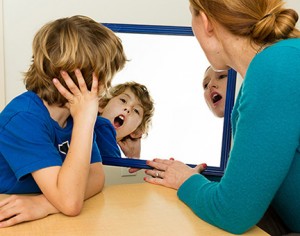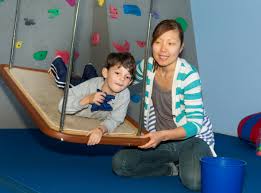cscadmin
THE IMPORTANCE OF TOUCHY-FEELY LEARNING AND PLAYTIME
To increase your child’s hands-on learning and play, try these fun activities with him or her at home:
- Do a puzzle with your child – this classic, fun “game” doubles as an exercise to stimulate visual, hand, and brain coordination.
- When helping your child to learn his or her letters, try having him write the letters in shaving cream to enhance the feeling plus visual connection. To avoid messes, keep an artist’s tarp handy to throw over your kitchen table, or engage in this fun, interactive form of “gooey” learning on a backyard patio table that can be hosed down!
- Have fun learning numbers with a game of stacking toys – count with your child (1, 2, 3) as he or she physically moves a stacking piece to the top of the pile.
- Learn about geometric patterns and shape names with the highly physical action of placing those items into a shape sorter (rather than just viewing a one dimensional shape on a piece of paper or in a book). The same can even be done while baking with your child by picking up a few new types and shapes of cookie cutters to create an in-the-kitchen game that can dual as a fun, interactive lesson in size and depth!
With a few simple learning tools and a bit of imagination, you can easily enhance your little one’s hands-on learning experience in your own home.
“PLAYTIME PALS” HELPS TODDLERS GEAR UP FOR PRE-SCHOOL!
Child Success Center is pleased to be launching “Playtime Pals” this fall – an early intervention and enrichment program that utilizes a play-based approach to hands on learning. Designed to aid parents as their little ones gear up for entry into pre-school, Playtime Pals combines a variety of therapeutic approaches to foster the overall growth and development of children.
Continue reading
GET SET FOR KINDERGARTEN!
For parents wanting to ensure their kids are ready for kindergarten it can be a worrisome time! Yes, kids entering kindergarten today are expected to have a greater foundation for writing and reading basics, but it doesn’t need to be a tearful or terrifying process to prepare them for this important milestone. A child’s ability to grasp, learn and embrace new concepts and ideas is significantly enhanced when learning is done in an environment and with methods he or she already knows well. Learning through kinesthetic play as part of the process is extremely effective because it’s far more enjoyable for kids. While some preschools are slowly incorporating more of this concept into their curriculum, some state of the art learning centers, such as Child Success Center, have centered entire tutoring and learning programs around this platform.
Continue reading
Childhood Communication Issues
It’s understandable that nothing is more disheartening to a parent than to think that their child is developing less than perfectly in every way, but it is part of being human. We all develop at different rates and in different ways. Just as babies require help developing the skills needed to feed themselves, sometimes children also greatly benefit from help overcoming communication issues.
Communication issues can manifest themselves in how a child speaks or how they understand speech. As a side effect of communication issues, children who have trouble communicating their thoughts or feelings, or children who have trouble processing the meaning or clarity of what is being said to them, often can become frustrated and act out with unexpected or unwanted behavior. Parents who are dealing with both communication issues and unwanted behavior often see a dramatically happier and more expressive child soon after treatment begins.
The role of therapists in treating childhood communication issues.
To better understand the challenges and treatment process, it helps to understand the focus and role of different therapy professionals such as occupational therapists and therapists that work with speech and language difficulties.
Occupational therapists work with children who have sensory processing disorders (SPD). A child with SPD will find it difficult to process and act upon sensory information, creating challenges in performing daily tasks.
The Vestibular System and Auditory Processing and Language Disorders
One of the most basic of all the sensory systems is the vestibular system. As described by noted author and therapist Carol Stock Kranowitz, M.A. in her 2009 book, The Vestibular System and Auditory-Language Processing: “The vestibular system coordinates body movements, maintains balance and equilibrium, and helps children develop normal muscle tone.” She further writes, “The vestibular system plays a significant role in the development of language, so that children with vestibular dysfunction may also have auditory-language processing difficulties. The two systems work together as they process sensations of movement and sound. The two systems are closely connected because they both begin to be processed in the receptors of the ear.”
While occupational therapists treat children with vestibular dysfunction, speech therapists work with children who have auditory processing difficulties and language disorders. Some auditory processing skills include auditory discrimination (differentiating among sounds), auditory figure/ground disturbance (discriminating between sound in the foreground and background) and language.
Language Disorder
When a person has trouble understanding others (receptive language), or sharing thoughts, ideas, and feelings (expressive language), then he or she has a language disorder.
Speech Disorder
When a person is unable to produce speech sounds correctly or fluently, or has problems with his or her voice, then he or she has a speech disorder.
 Speech therapists provide therapy to children with speech disorders. Kranowitz further explains, “Language and speech are closely related, but are not the same. Speech is the physical production of sound. Speech skills depend on smoothly functioning muscles in the throat, tongue, lips, and jaw. The vestibular system influences motor control and motor planning that are necessary to use those fine muscles to produce clear speech.”
Speech therapists provide therapy to children with speech disorders. Kranowitz further explains, “Language and speech are closely related, but are not the same. Speech is the physical production of sound. Speech skills depend on smoothly functioning muscles in the throat, tongue, lips, and jaw. The vestibular system influences motor control and motor planning that are necessary to use those fine muscles to produce clear speech.”
Overall, the child with vestibular dysfunction frequently develops problems with speech and language. Here are some common characteristics of children with poor speech, language, and/or auditory-language processing:
- May have trouble discriminating between sounds, such as the difference between “comb” and “cone.”
- May have trouble attending to, understanding, or remembering what she reads or hears.
- May misinterpret requests, frequently ask for repetition and be able to follow only one or two instructions in sequence.
- May have trouble putting thoughts into spoken or written words.
- May talk “off topic,” e.g. talk about his/her new shirt when others are discussing a soccer game.
- May have trouble “closing circles of communication,” i.e. responding to others’ questions or comments.
- May have weak vocabulary and use immature sentence structure (poor grammar and syntax).
- May have difficulty speaking and articulating clearly.
- May improve her speaking ability after she experiences intense movement.
 According to Kranowitz, “Moving activates the ability to speak. A child with vestibular and language problems benefits greatly from therapy that simultaneously addresses both types of dysfunction. Speech therapists report that just putting the child in a swing during treatment can have remarkable results. Occupational therapists have found that when they treat a child for vestibular dysfunction, speech-and-language skills can improve along with balance, movement, and motor planning skills.”
According to Kranowitz, “Moving activates the ability to speak. A child with vestibular and language problems benefits greatly from therapy that simultaneously addresses both types of dysfunction. Speech therapists report that just putting the child in a swing during treatment can have remarkable results. Occupational therapists have found that when they treat a child for vestibular dysfunction, speech-and-language skills can improve along with balance, movement, and motor planning skills.”
The development of communication skills begins in infancy. Any communication issue is likely to have a significant effect on the child’s social and academic skills and behavior. The earlier a child’s speech and language problems are identified and treated, the less likely it is that problems will persist or get worse.
An in-depth overview of the vestibular system can be found in the book by Carol Stock Kranowitz, M.A. (2009), The Vestibular System and Auditory-Language Processing.
Parents are also urged to contact Child Success Center to learn more about the treatments and therapies available to help their child. CSC can be reached at 310-899-9597
When will my child talk?
Language is a development process and each step builds on the previous step. A child begins to communicate at birth through the use of cries. Typically, a caregiver can distinguish cries that indicate hunger, pain, tired, and frustration. As a child grows, he/she begins to develop sounds. The first sounds produced are uttered from the “back of the throat”. Eventually, a child will begin to babble (e.g. mamamama, dadadada, bababa). These sounds are all very similar (i.e. repeated sounds). Babbling is shaped into simple words. As simple words emerge, a child produces jargon. Jargon means a child is producing sounds that seem to portray the intonation of a sentence and have meaning but the child is using non-sensible words. Again, each step during language development builds upon each other.
Continue reading
Enrichment vs. Early Intervention & Remediation: What You May Not Know
It is a commonly held misconception that children require a diagnosis of autism, Attention Deficit (Hyperactive) Disorder or a medical diagnosis of cerebral palsy to require or benefit from early intervention. All that is required is that a child is struggling functionally in the areas of social emotional development, sensory-motor development, language and communication development, or foundational learning skills/academic development.
Continue reading
Turn Up the Volume on Learning with Music and Sound
Most children have become accustomed to the steady stream of the ongoing soundtrack of daily life. However, for some, normal sounds such as that of a bus driving by, the ticking of a clock, children talking and yelling in the next room or the ring of school bells can all cause anxiety and are all common concerns for kids with auditory processing challenges. Even routine noises such as public toilets flushing can be scary or bothersome for some kids. Luckily there is a simple yet effective program called Therapeutic Listening.
Too Revved Up to Sit Still?
All children need movement and plenty of exercise, which they get throughout the summer with camps, swimming and play-dates. However, when school starts up again, the emphasis switches from outdoor play to sitting at a desk and children are expected to sit still and listen quietly for hours on end. Some children learn to handle this transition, whereas others, especially those with sensory processing issues, find this change much more challenging. When school starts, we need to keep in mind that our kids who crave sensory input still need a lot of movement breaks. The ALERT program is a strategy to help kids recognize and name their arousal level in order to better self-regulate throughout the day. This is a perfect strategy for the classroom because it helps kids monitor themselves and also effectively communicate their needs to their teachers. Many teachers do not understand sensory integration disorder and will think your child is just being “naughty.” Continue reading
Is Your Child’s Handwriting Ability Slowing Their Academic Progress?
Sensory Perception and Handwriting Skills
Each school year academic challenges increase. It is crucial for a child to have strong handwriting skills to help them master these new challenges, without the task becoming overwhelming. Handwriting efficiency is influenced by a variety of factors, including a child’s sensory perception.
Continue reading
How Visual Perception Can Affect a Child’s Learning
School requires a great deal from every sensory system and if even one system is delayed, a student could  struggle with learning to read, write, socialize and attend to his/her teacher’s lessons.
struggle with learning to read, write, socialize and attend to his/her teacher’s lessons.
The visual system is possibly the most powerful, yet most overlooked, sensory system in the body. Even if a child has “perfect” visual acuity (20/20) they may still have other visual deficits that can hinder their school success. There are many types of visual perception that interpret what we see.

